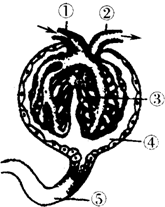如图是肾单位结构示意图,请据图回答:
(1)写出结构名称:④______
(2)③内的液体是______;④内的液体是______.
(3)在尿的形成过程中⑤起的作用叫______作用.
(4)医生在检验某人的尿液时发现了较多的红细胞,可能是[③]______出现病变.

(1)图示肾单位的结构示意图,从图中可以看出:①入球小动脉,②出球小动脉,③肾小球,④肾小囊,⑤肾小管.
(2)血液流经肾小球时没有发生气体交换的作用,只进行了过滤作用,因此图中[①]入球小动脉、[③]肾小球和[②]出球小动脉内流动的血液是动脉血.
(3)当血液流经肾小球时,血液中除血细胞和大分子的蛋白质外,其余的像水、无机盐、葡萄糖等小分子的物质被过滤到肾小囊腔中形成原尿;原尿在流经肾小管时,大部分水、全部葡萄糖和部分无机盐等经重吸收作用送回血液,剩下的像少量水、无机盐、尿素等物质形成尿.因此在尿的形成过程中⑤起的作用叫重吸收作用.
(4)当肾小球发生病变时,会导致肾小球的通透性增大,本不能滤过到肾小囊腔的血细胞和蛋白质会进入肾小囊腔中,但肾小管对血细胞和蛋白质没有重吸收能力,因此这些血细胞和蛋白质就会随尿液排出而形成血尿或蛋白尿.因此,医生在检验某人的尿液时发现了较多的红细胞,可能是[③]肾小球出现病变.
故答案为:
(1)肾小囊;
(2)动脉血;原尿;
(3)重吸收;
(4)③;肾小球.
